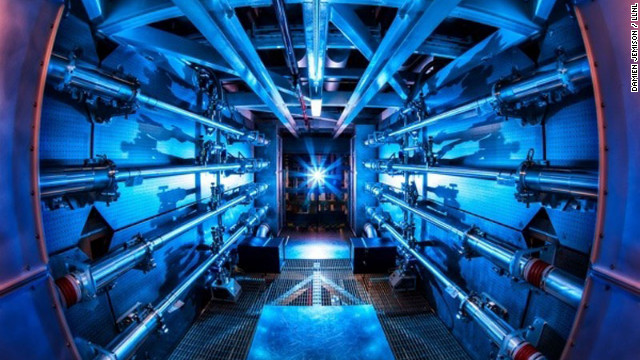
For all the heady talk about misleadingly "deific," recently confirmed quantum specks named after Scottish physicists, another kind of historic event just transpired: a record-shattering laser beam that, in a single shot fired on July 5, 2012, generated more power than the United States does at any single instant.
Spooky or astonishing? How about both. Think of it as "extreme sports science," a kind of lab-based game of automatic one-upmanship where researchers fiddle with incredibly complex, painstakingly calibrated machinery to produce unprecedented results -- then outdo them.
Time.com: 9 examples of improbable superhero technology
That's what the National Ignition Facility -- home to the world's largest laser -- just did when it pulled the trigger on 192 beams of optically amplified, electromagnetic radiation-emitting light, all fired within a few trillionths of a second of each other, to deliver 500 trillion watts (or terawatts) of "peak power" and 1.85 megajoules of ultraviolet laser light.
Framed in more eye-catching terms: The NIF says 500 terawatts outpaces the entire U.S. for power used "at any instant in time," and that 1.85 megajoules amounts to roughly 100 times what any other laser produces regularly. No wonder those two power unit prefixes (tera, mega) come from Greek words meaning "monster" and "great."
Then again, what else would you expect from a laser housed in a building the size of three football fields, or a science lab with a word like "ignition" in its moniker?
The NIF, located in Livermore, California, came online in March 2009, and its goals are manifold: Its primary mission, given funding by the National Nuclear Security Administration (NNSA) -- "a semi-autonomous agency within the U.S. Department of Energy responsible for enhancing national security through the application of nuclear science to the nation's national security enterprise" -- is to duplicate what happens in contemporary nuclear weapons, in part to render underground nuclear testing unnecessary.
Time.com: Clamshell! The story of the greatest computing form factor of all time
But it's also a repository for scientists -- the same sort that poke around at sub-sub-atomic levels for elemental quantum particles -- looking to understand "extreme states of matter that exist in the centers of planets, stars and other celestial objects."
And last but not least -- well beyond the holster-loaded conventions of mere pulp sci-fi skirmishing -- the NIF laser is about puzzling out something called "fusion ignition": the point at which nuclear fusion reactions become self-sustaining, to, in the NIF's words, "provide abundant and sustainable clean energy."
Fusion reaction is arguably the most exciting of the NIF's goals: to catalyze self-sustaining nuclear fusion, wherein two light atomic nuclei "fuse" together and produce a single heavier nucleus while converting some of that mass to incredible amounts of energy. That, in so many words, is how stars are born, and it's something scientists have been working to achieve since the 1950s.
The 500-terawatt shot on July 5 brings scientists closer to solving a longstanding physics challenge and arguably the field's holy grail: getting back more energy than you give.
Full News...
No comments:
Post a Comment